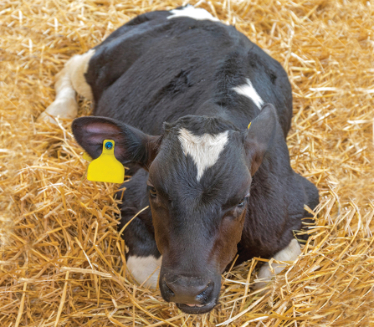Bedding Considerations – Comfort to Economics

By Jaclyn Krymowski.
Stall design and facility setup are some key factors in selecting the right bedding. Finding something that optimizes comfort and finances is crucial to ensure you are not only making your cows comfortable, but also getting a return on the investment.
All About Comfort
Cow comfort and farmer practicality should be in harmony with each other as much as possible for stalling.
For lactating cows, bedding needs to not only accommodate the changing seasons, but also remain high and dry to discourage pathogen growth. Calves need a system that allows them to “nest” and stay dry, especially in cold conditions.
Broader farm management concerns center around economics, labor efficiency and compatibility with manure handling systems. This is a special concern for those who need to meet confined animal feeding operations or CAFO status dictated by state governments.
Healthy laying conditions for all sectors of the herd, from calves through dry cows, hinges not just on bedding, but stalls as well. If freestalls are too short or narrow, for example, it doesn’t matter how nice the bedding is, animals will avoid them. Likewise excessive stocking density in open pens can lead to overly wet bedding that needs to be replaced more frequently.
Another benefit of bedding and resting is the avoidance of over standing. Constant standing for long periods of time, especially on hard and abrasive surfaces like concrete, leads to an increase in hoof lesions and lamenses. Reducing the stress placed on a cow’s legs is important and if not maintained can lead to culling.
Dairy producers have a wide variety of bedding surface options for free stalls. Dr. Naomi Botheras, animal welfare program specialist at The Ohio State University, cites the objective for optimal bedding as bedding that provides cushion, comfort, traction, low abrasion risk, thermal insulation, and is clean and dry, and easy to maintain in her article, Free Stall Bedding Options: Important Considerations from the Cow’s Perspective.
Weighing the Options
As we dive into these options, let’s break down the pros and cons of each bedding option. As briefly mentioned before, you should also consider location and what works best in your climate.
Composting material is often used in open style barns. It starts with wood shavings or sawdust and then, as manure builds up, new material is added periodically. Using this type of bedding method requires very good ventilation and extra attention to teat care at milking. In this type of system, the key to success is maintaining teats so that they don’t get contaminated or infected as organic matter can be a breeding ground for pathogens.
“Sawdust and Wood shavings are probably the most commonly used bedding products for dairy cows. They have the advantage over sand of being broken down by microorganisms in the disposal system, but they have the disadvantage of allowing growth of microorganisms (pathogens),” says Botheras. “Addition of lime to bedding may reduce growth of pathogens. The smaller particle size of sawdust makes it more absorbent than wood shavings and quicker to break down. However, small particle size is also associated with rapid growth of bacteria and other harmful pathogens.”
Straw is another fairly common bedding that can be used in a compost system or on its own. It tends to be an affordable option (depending on the year and availability of wheat as straw). Straw composts well and reduces in volume when composted. Particle size is important to encourage comfort and reduce the time required to break down as it is composted.
Another commercially available option are geotextile mattresses, which can be used in either tie stall or free stall barns. These waterproof mattresses are often made from materials such as rubber crumbs, polyethylene foam, and water. Although they are marketed as requiring no bedding, research suggestions providing added bedding encourages cows to lay down. These can also typically be made to size to fit the stall.
“With mattresses, it is recommended to bed daily rather than alternate-day bedding to control bacteria on the surface because organic bedding is commonly used on top of mattresses,” writes Kim Clark, dairy extension educator with the University of Nebraska-Lincoln, in her article Making the Best Bed: Pros and Cons of Bedding Options.
In additon to cleanliness and lower somatic cell counts, Clark says mattresses provide a cushioned area for lame cows. Additionally, mattresses bedded with lime have the lowest counts of environmental pathogens.
On the flip side, higher swollen and injured hock scores have been found with mattresses, Depending on how they are installed, mattresses can lead to discomfort.
Another good bedding choice is sand with a depth of 6-8 inches. Sand is known for its ability to be “clean” as it doesn’t promote pathogen growth. The potential downside is disposal. Sand can cause issues with storage and handling especially for large scale liquid manure facilities and/or slatted floors. But sand also has a benefit that it can be recycled via reclamation lanes and facilities. These additions can be costly, so carefully weigh savings vs investment before you fully commit to sand.
Beyond disposal, sand can also quickly become concave and flatten fairly quickly, causing laying time to decrease. Routine raking and cleaning are essential to keep this bedding type favorable.
“Particle size is important, as sand too small in particle size will hold water well, and large particle size is not comfortable for cows to lie on,” writes Clark. “Very fine sand provides less drainage because the fine sand fills voids between larger particles and allows pooling or pockets of moisture.”
Cows also tend to stay cleaner and have fewer leg injuries as coarse sand provides protection against slippage.
Factoring in the Economics
We’ve gone through the various bedding options and benefits and drawbacks on the cow comfort side, but what does that look like for your pocket book?
Another aspect of economics involves the cost of caring for cows with leg injuries and thus decreased production.
“Increased lying behavior is associated with a reduction in the occurrence of lameness, increased rumination, and increased blood flow to the udder, which may ultimately increase longevity, lower health costs, increase productivity, and improve cow welfare,” writes Botheras.
Simultaneously, the different styles should also complement your unique facilities, equipment and manure handling program. Maximizing cow comfort not only helps from a welfare aspect, but benefits the cow in and out of the parlor with an increased longevity.



